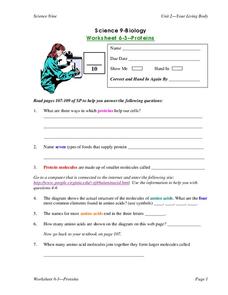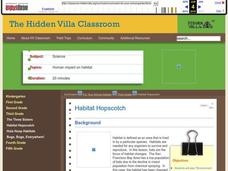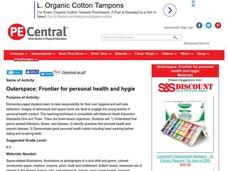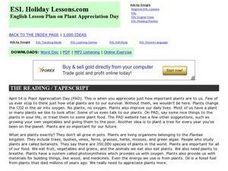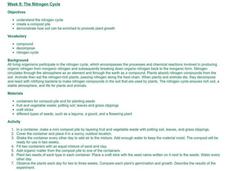Curated OER
Circle of Life
Students consider why we eat and where our food obtains its energy. They illustrate food chains that might be found on an open field, dissect owl pellets, identify the remains of animals in the pellets, watch videos and participate in...
Curated OER
How Big is Your Footprint?
Students create awareness for ways in which the "Western" lifestyle negatively impacts the Earth. They create awareness for alternatives to our current ways of living, eating and traveling. Students are challenged to talk with their...
Curated OER
Food Webs
Students recognize interdependence in a food web by using yarn and notecards to create a food web and discussing what would happen if one of the organisms from a certain trophic level is removed.
Curated OER
Proteins
In this proteins worksheet, students name the types of foods that supply proteins and determine how the body uses proteins. Students understand how to acquire complete proteins. This worksheet has 1 graphic organizer, 9 short answer, and...
Curated OER
Habitat Hopscotch
Third graders explore animal characteristics by participating in a bat environment game. In this natural habitat lesson plan, 3rd graders identify the physical anatomy of a bat and discuss their eating and sleeping habits. Students...
Curated OER
Life in the Ocean
For this ocean worksheet, high schoolers review the different life forms that can be found in the ocean and how these organisms are connected to each other. This worksheet has 12 short answer questions.
Curated OER
Animal Adaptations: Focus on Bird Beaks
Sixth graders explore bird beaks as animal adaptation. In this bird adaptation lesson, 6th graders conduct an experiment to determine the connection between the shape of a bird's beak and the food it eats.
Curated OER
Outerspace: Frontier for Personal Health and Hygiene
Pupils view photos of astronauts sleeping, eating, bathing, and using the toilet, and discuss hygiene problems in a zero-gravity environment. They contrast hygiene habits in space to those on Earth, and create storybooks illustrating...
Curated OER
The Digestive System
Sixth graders use the Internet to examine the human digestive system. Using a diagram, they identify and explain the functions of each organ involved in the digestion process. They complete an online activity as well to end the activity.
Curated OER
ESL Holiday Lessons: Plant Appreciation Day
In this language skills worksheet, students read an article about Plant Appreciation Day. Kids respond to 6 matching questions, 29 fill in the blank questions, 30 multiple choice questions, 12 word scramble questions, 30 short answer...
Curated OER
ESL Holiday Lessons: Pancake Day
In this language skills worksheet, students read an article about Pancake Day. Students respond to 6 matching questions, 29 fill in the blank questions, 30 multiple choice questions, 12 word scramble questions, 30 short...
Curated OER
Peanut Butter Broccoli
Fifth graders explore food production by viewing DNA presentations. For this genetic engineering lesson, 5th graders discuss the foods they typically eat at home and how many common foods are engineered in a way that can produce a bigger...
Curated OER
Producers, Consumers, and the Food Chain
Third graders discuss producers, consumers, and the food chain. In this producers and consumers instructional activity, 3rd graders talk about organisms, the food chain, and the difference between producers and consumers. They complete...
Curated OER
Ecosystems - Plants and Animals Together
Students study the biotic and abiotic factors of an environment. In this exploratory lesson students examine the different trophic levels and how organisms are connected.
Curated OER
Going on a Living and Nonliving Hunt
Third graders explore various objects and organisms to begin to distinguish between things that are living, things that were once-living, and things that are nonliving.
Curated OER
The Nitrogen Cycle
Young scholars design and create a compost pile in order to study the Nitrogen Cycle. They then use the scientific method to determine if plants grow better when they add organic matter from their compost pile to the plant's soil.
Curated OER
Science – How Living Things are Grouped
In this classification of living things worksheet, students respond to 7 short answer, 10 true or false, 4 multiple choice, and 4 graphic organizer questions regarding how living things are grouped.
Curated OER
Fun Photosynthesis
Second graders, using large colored poster board, explore photosynthesis and its effect on the food chain and survival of organisms.
Curated OER
Friendly Patter Poetry
Students create a free from poem on the topic of friendship. They read examples of free form poetry to gather ideas. Through the use of a graphic organizer, students generate a list of friendship characteristics which is used to create...
Curated OER
Taste Treat Writing
Students use their 5 senses to write a paragraph about yummy treats they sample. In this writing lesson plan, students use a graphic organizer to organize their tastes and how they can write about them and then write.
Curated OER
Taxonomy Project
Young scholars act as a taxonomist and, given a certain situation, classify existing organisms.
Curated OER
Bridges for All Lesson 1: Fighting Chance (1850-1877)
Pupils study how a Quaker woman, Laura Smith Haviland, served as a lifeline for fugitive and freedmen during the American Civil War era. They research other philanthropic organizations and the associate vocabulary of this era.
Curated OER
Pseudogene Suite
Students use Biology Workbench to explore DNA sequence data for the GULOP gene in humans, chimpanzees, orangutans, and crab-eating macaques and the beta globin gene and its pseduogene in humans, gorillas, and chimpanzees.
Curated OER
Fresh Greens In The Home
Students engage in the study of nutritional food choices that include fresh greens. They investigate the benefits of using simple planting techniques. The instructional activity also includes recipes for students to try out the habit of...



